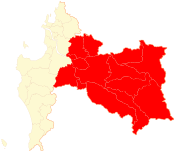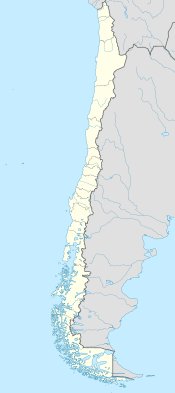Biobío Province facts for kids
Quick facts for kids
Biobío Province
Provincia de Biobío
|
||
|---|---|---|
|
||

Location in the Bio Bío Region
|
||
| Country | Chile | |
| Region | Bio Bío | |
| Capital | Los Ángeles | |
| Communes |
List of 14
|
|
| Government | ||
| • Type | Provincial | |
| Area | ||
| • Total | 14,987.9 km2 (5,786.9 sq mi) | |
| Population
(2012 Census)
|
||
| • Total | 373,981 | |
| • Density | 24.95219/km2 (64.62589/sq mi) | |
| • Urban | 245,775 | |
| • Rural | 107,540 | |
| Sex | ||
| • Men | 176,960 | |
| • Women | 176,355 | |
| Time zone | UTC-4 (CLT) | |
| • Summer (DST) | UTC-3 (CLST) | |
| Area code(s) | 56 + 43 | |
| Website | Government of Biobío | |
Biobío Province (which is Provincia de Biobío in Spanish) is one of the three provinces in the Biobío Region of Chile. Its main city and capital is Los Ángeles. In 2002, about 94,716 people lived there.
This province is surrounded by other provinces. To the north, west, and south, it borders Concepción, Arauco, and Malleco. To the east, it shares a border with Argentina.
Biobío Province covers an area of about 14,987.9 square kilometers (5,786.8 sq mi). It has many forests and mountains. Because of this, it exports a lot of timber. In 2012, the population was 373,981 people.
A major railway line runs through the western part of the province. This railway connects Santiago in the north to Puerto Montt in the south. It also links the province to the port city of Concepción. Los Ángeles is about 25 kilometers (16 mi) east of this railway. A smaller branch line connects Los Ángeles to the main railway.
Contents
History of Biobío Province
The Biobío Province was officially created on October 13, 1875. At that time, it was part of a larger area called the Province of Araucan. Later, in 1887, the Province of Malleco was separated by President José Manuel Balmaceda.
The province got its name from the Bio-Bio River, which flows through it. When it was first formed, the Province of Biobío was divided into three smaller areas called departments. These departments were La Laja, Mulchén, and Nacimiento. Each department had its own capital city.
In the 1970s, Chile changed how its regions were organized. This led to the creation of the Biobío Region. By a special decree on November 4, 1975, the Biobío Region (also known as the VIII Region) was formed. It included the provinces of Biobío, Arauco, and Concepción.
Ñuble used to be part of Biobío Province. However, on September 5, 2018, Ñuble became its own separate region.
How Biobío Province is Governed
Biobío is a second-level administrative division in Chile. This means it's a major area within a larger region. It is governed by a governor. The governor is chosen by the President of Chile.
Communes of Biobío Province
The province is made up of 14 smaller areas called communes. Each commune has its own local government. This government includes an elected mayor, called an alcalde, and a municipal council.
- Alto Bio Bío
- Antuco
- Cabrero
- Laja
- Los Ángeles (capital city)
- Mulchén
- Nacimiento
- Negrete
- Quilaco
- Quilleco
- San Rosendo
- Santa Bárbara
- Tucapel
- Yumbel
Geography and Population
According to a census taken in 2002 by Chile's National Statistics Institute (INE), Biobío Province covers an area of 14,987.9 square kilometers (about 5,786.8 sq mi).
At that time, the province had a population of 353,315 people. This included 176,960 men and 176,355 women. This means there were about 23.6 people living in each square kilometer. Biobío is the tenth most populated province in Chile.
Most of the people, about 245,775 (69.6%), lived in cities or towns. The rest, 107,540 people (30.4%), lived in rural areas. Between the 1992 and 2002 censuses, the population of the province grew by 9.1%, which is an increase of 29,405 people.
Bio Bío Valley Wine Region
The Bio Bío Valley is also a special area known for making wine. It's located within the Biobío Province and Region. This area is one of Chile's southern wine regions. It is famous for its fresh and flavorful wines.
The region is located at a latitude of 36°S. This is similar to places like southern Spain or Monterey in California. Most of the vineyards are found between 50 meters (164 ft) and 200 meters (656 ft) above sea level. The climate here is a moderate Mediterranean climate.
The Bio Bío Valley gets about 1,275 millimeters (50 inches) of rain each year. This is one of the highest rainfall amounts among all Chilean wine valleys. However, strong winds help to prevent too much humidity. This is similar to what happens in northern France.
For most of the 1900s, the main types of grapes grown here were Moscatel de Alejandria and Pais. Pais grapes are also known as Missiones in the USA. Today, other grapes like Pinot Noir, Chardonnay, and Sauvignon Blanc are also grown throughout the valley.
Some wines from this region have won awards. For example, the Co-Op's Bio Bío Valley Malbec wine from 2014 won a silver award at the International Wine Challenge. It also received a bronze award from Decanter magazine.
Grape Types and Climate
The Bio Bío Valley has a moderate Mediterranean climate. It receives about 1,275 millimeters (50 inches) of rain each year. Even with a lot of rain, winds help to keep the air from getting too humid.
The soils in this area are made of alluvial soils, clay, and sand. The main grapes grown here are Pinot noir, Chardonnay, and Sauvignon blanc.
Here are some of the grape types planted and their areas:
- Cabernet Sauvignon: 145 hectares (358 acres)
- Pinot Noir: 158 hectares (390 acres)
- Moscatel de Alexandria: 142 hectares (351 acres)
- Pais (Mission): 1,148 hectares (2,837 acres)
In total, about 446 hectares (1,102 acres) are planted with grapes in this region.
See also
 In Spanish: Provincia de Biobío para niños
In Spanish: Provincia de Biobío para niños
- Chilean wine



